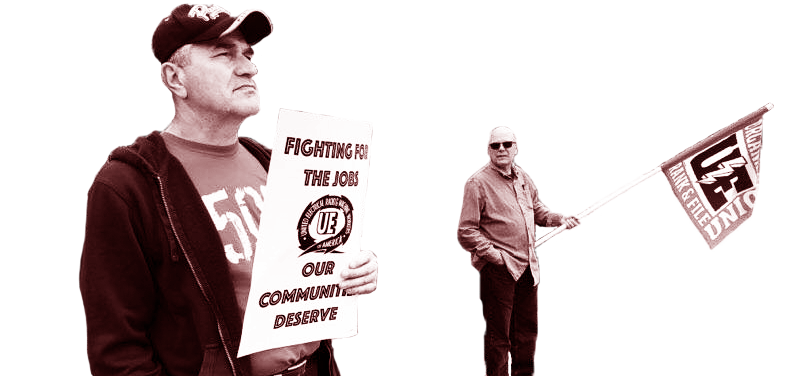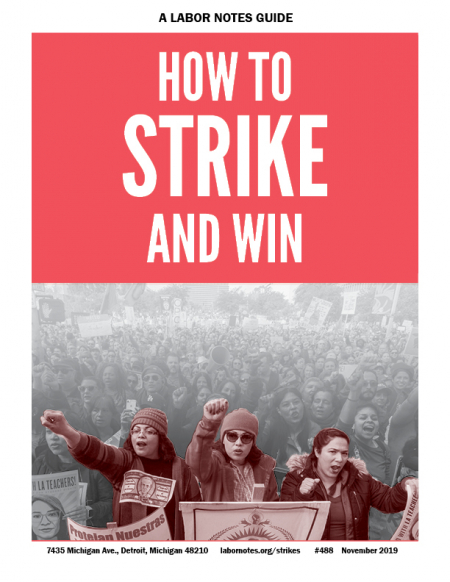Democracy: Who Owns the Strike?

Strikes work when rank-and-filers devise the strategy, own the strategy, and believe in it. Photo: UE.
A powerful strike must belong to its members, from the beginning of the contract campaign to the day you declare victory.
How to Strike and Win
A Labor Notes Guide
labornotes.org/strikes
The Big Picture
Know Your ABC's
Building Blocks
- Turn Up the Heat
- Organize the Organized
- Democracy: Who Owns the Strike?
- Community: Who Else Owns It?
- How to End a Strike
At a Glance
Democracy is not simply a moral question—we need it, to build strong unions and to win strikes. A strike is a great opportunity to exponentially expand the number of us who have the skills, confidence, and authority to be the union. Leaders need to welcome, not begrudge, rank-and-file initiative.
In West Virginia's 2018 teacher strike, leaders couldn't have called members out on a sudden unlawful walkout simply by decreeing it from the top. That strike worked because rank-and-filers devised the strategy, owned the strategy, and believed in it. It was theirs.
A democratic strike requires an informed strike vote. The strike and the bargaining table must both be run by democratically elected committees that represent the whole membership.
DEVELOP DEMANDS TOGETHER
Start your contract campaign with a bargaining survey every member can fill out, identifying and ranking which issues the contract should address. The results should inform bargaining. If union leaders don’t do a survey, a rank-and-file caucus can organize one.
The survey sets the tone that the campaign will require everyone’s input. Try for 100 percent participation. Hand-distribute and collect it, for a first test of your communication network (see p. 20). Ask for everyone’s current contact info.
Be sure to include an open-ended, write-in question; you may get some surprising information. But also ask specific questions. When Teamsters Local 814 asked the general question “What are your top contract issues?” many members responded simply: “More money.” But when asked how they would split a dollar between wages and retirement, the majority favored putting 50 percent or more into retirement accounts.
Next, members should help shape the survey data into bargaining demands. Teachers in Los Angeles held meetings by area of the city and by job. Their campaign highlighted not only the issues of classroom educators but also demands specific to minority groups in the union, such as school nurses and librarians. Parents and community groups helped formulate additional demands.
Be sure you’re asking for something for everyone—the second tier, the night shift, the secretaries, the janitors, and possibly your key allies outside the union.
BRING BIG CROWDS TO BARGAINING
Management would prefer to bargain discreetly with a few union representatives. Often the employer will propose a gag rule where members are kept in the dark until negotiators have reached a deal.
It’s in the interest of union power, as well as democracy, to do the opposite. Elect a large bargaining team that includes rank-and-file members from every work area or job. The committee should also be representative of the workforce in all important ways. If half the workers are women, the bargaining team should not be all men.
Keep bargaining sessions open for any member to observe. Some unions have gone one step further and brought in community allies. See here.
Invite members to testify about their experiences on a particular issue that’s being discussed. On certain days, organize a big crowd to pack the room and show your strength.
Nurses at the University of Vermont Medical Center turned out by the hundreds twice in their 2018 contract campaign—once for the first negotiating session and once for the last session before their strike. They all wore red shirts and walked in chanting “Safe staffing saves lives,” and “Hey [CEO] Brumsted, what do you say? How many beds did you make today?” These actions were among many other steps in an escalating campaign (see here).
Teacher negotiators in Concord, Massachusetts spent their first two bargaining sessions debating the idea of opening up to all members; the school district was resisting. For the third session, the teachers just went ahead and did it—they brought 50 co-workers. By the end of the day the employer agreed to keep bargaining open. It’s harder to argue for excluding people who are in the room already!

SUPPORT LABOR NOTES
BECOME A MONTHLY DONOR
Give $10 a month or more and get our "Fight the Boss, Build the Union" T-shirt.
Open bargaining kept members much more connected to the process, reported President Merry Najimy: “Being a witness at the table is completely different than just getting a report afterwards. Members who witness the process themselves feel more informed—and they get fired up at the disrespect the School Committee shows for teachers. People are upset when they have to miss a session.”
MEMBERS DESERVE AN INFORMED, DEMOCRATIC VOTE
This goes for the vote to authorize a strike—and the vote to end the strike.
How can you prepare an informed strike vote? In some unions, this vote is routine: everyone votes yes without really expecting a strike. You need serious debate before the vote is taken. What is the percentage you’ll need before you’ll decide to walk?
And at the other end, members shouldn’t be asked to vote on a deal when they’ve seen only its “highlights,” or gotten details only at the ratification meeting itself.
Bargainers should circulate the whole tentative agreement, with changes indicated, and be frank about the pros and cons and why they are recommending a yes or no vote. Members need adequate time to review it, ask questions, and talk it over together.
The decision to strike, or to stop striking, isn’t just about how good the deal is. It’s also a question of strategy—who is winning? If we stay out, could we get more? What are the risks? Do we have any cards left to play?
The members have to be part of these conversations throughout the campaign, so they can cast an informed vote when the time comes. For how Chicago teachers did it in 2012, see here.
MEMBERS DEVISE TACTICS AND RUN PICKET LINES
In a contract campaign and during a strike, there’s plenty of work to do. Everyone should have a role. Who’s making picket signs? Who’s bringing coffee? Who’s assigned to talk to the press? Who can take attendance, drive a carpool, direct traffic, watch out for scabs, leaflet the public? Who’s coordinating all those assignments? How is everyone staying in touch?
The strike at the Four Roses bourbon distillery near Frankfort, Kentucky was organized, managed, and staffed almost exclusively by rank-and-file members, not officers or staff. Workers made their own signs, handled all media interviews, organized picket shifts and parking, and maintained a round-the-clock presence to monitor for scabs.
“You can’t wait for other people to step up,” said Jeff Scott, a boiler operator. “We probably put in more hours working the picket line than we would’ve if we’d been working.”
Of course union staff and officers should add their brains and brawn, too. But they shouldn’t operate like bosses deploying foot soldiers. As a rule, members should be privy to the inside scoop, involved in all aspects of the campaign, and deciding what to do next.
Rank and filers dreamed up many of the tactics that beat Verizon during the 2016 strike there. Read more on p 19.
THE MORE COMMUNICATION, THE BETTER
Members can’t run the show if they don’t know what’s going on. You need a communication system that runs both ways—where everyone is regularly getting updates from bargaining and strike central, and everyone can feed in their ideas and intel from the front lines.
A strike website and a strike bulletin distributed to the picket lines and by email will help. Prepare for this in advance. There are also good tech tools to help. Mass text messaging systems have become a popular way for unions to rapidly disseminate information and solicit feedback. A Facebook group can be an informal discussion forum, and bargaining teams can use Facebook Live to give updates.
But these methods should supplement, not substitute for, the essential ingredient: a robust person-to-person communication network (see p. 20).
IT’S NOT OVER TILL THE MEMBERS SAY SO
During the bargaining process, what mechanisms are in place for members to review proposals and respond to them? When a tentative agreement is reached, how will members review and debate it before a vote? For more on how to stick the landing, see p. 26.





